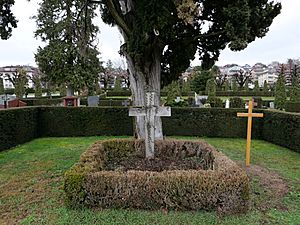Charles Ferdinand Ramuz facts for kids
Quick facts for kids
Charles Ferdinand Ramuz
|
|
|---|---|

Ramuz on a 200-francs Swiss banknote.
|
|
| Born | 24 September 1878 Lausanne, Switzerland |
| Died | 23 May 1947 (aged 68) Lausanne, Switzerland |
| Occupation | Novelist, poet |
| Nationality | Swiss |
| Alma mater | University of Lausanne |
| Period | 1903–1947 |
| Notable works | La Grande Peur dans la Montagne |
| Spouse | Cécille Cellier (1872–1956) |
Charles Ferdinand Ramuz (born September 24, 1878 – died May 23, 1947) was a famous Swiss writer. He wrote his books and poems in the French language.
About Charles Ferdinand Ramuz
Charles Ferdinand Ramuz was born in Lausanne, a city in Switzerland. He went to the University of Lausanne to study. After finishing his studies, he worked as a teacher for a short time. He taught in a Swiss town called Aubonne, and later in Weimar, Germany.
In 1903, Ramuz moved to Paris, France. He lived there until World War I started in 1914. Even while in Paris, he often traveled back to Switzerland to visit his home. During his time in Paris, he wrote about the poet Maurice de Guérin. In the same year, 1903, he published his first book of poems, called Le petit village.
When World War I began in 1914, Ramuz returned to live in Switzerland. He continued to write many books and stories. One of his famous works was the story for a musical play called Histoire du soldat. This play was created with the famous composer Igor Stravinsky.
Charles Ferdinand Ramuz passed away in 1947 in Pully, a town near Lausanne. For a while, his picture was even on the 200 Swiss franc banknote, which is a type of money in Switzerland. This shows how important he was in his country.
Today, there is a special group called the Foundation C.F. Ramuz. They give out an award called the Grand Prix C. F. Ramuz to other writers.
His Books and Stories
Charles Ferdinand Ramuz wrote many different kinds of books. He wrote novels, which are long stories, and also collections of poems. His stories often talked about life in the Swiss mountains and the people who lived there. Some of his books have been translated into English so people in other countries can read them too.
Here are some of his well-known works:
- Le petit village (1903)
- Aline (1905)
- Jean-Luc persécuté (1909)
- Aimé Pache, peintre vaudois (1911)
- Vie de Samuel Belet (1913)
- Le règne de l'esprit malin (1917) (also known as The Reign of the Evil One)
- La guérison des malades (1917)
- Les signes parmi nous (1919)
- Chant de notre Rhône (1920) (also known as Riversong of the Rhone)
- La grande peur dans la montagne (1926) (also known as Terror on the Mountain)
- La beauté sur la terre (1927) (also known as Beauty on Earth)
- Adam et Eve (1932)
- Farinet, ou la fausse monnaie (1932)
- Derborence (1934) (also known as When the Mountain Fell)
- Si le soleil ne revenait pas... (1937) (also known as As if the Sun were Never to Return)
- Paris, notes d'un vaudois (1938)
Awards He Received
Charles Ferdinand Ramuz was recognized for his writing during his lifetime.
- In 1927, he won the Prix Gottfried Keller. This is an important literary award in Switzerland.
See also
- Swiss literature
 In Spanish: Charles Ferdinand Ramuz para niños
In Spanish: Charles Ferdinand Ramuz para niños


